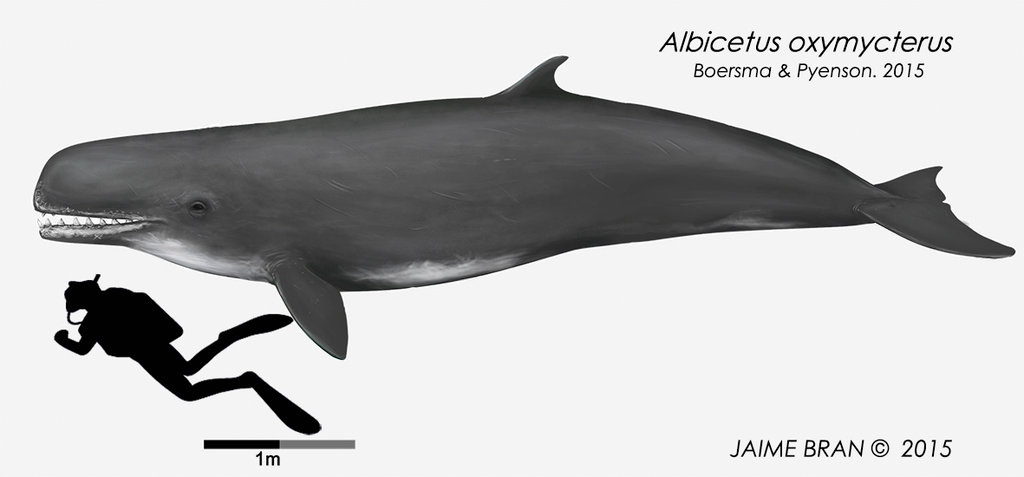Welcome to Albicetus

Name Definition
White whale
Name Given By
A. T. Boersma and N. D. Pyenson in 2015 (Arthur Kellogg originally named the species in 1925)
Location
possibly Monterey Formation of Santa Barbara city in California, U.S.
Classification
Mammalia, Artiodactyla, Cetacea, Physeteroidea
Size
through size extrapolation using its remains, Albicetus has been estimated to be about 6 meters long
Temporal Range
around the Langhian stage of the Miocene epoch, ~16 - 14 million years ago
Ecological niche
macroraptorial whale (meaning a large predatory whale)
Species/Sub Species
A. oxymycterus
Diet
because of its large size and large dentition, Albicetus might have had preference for hunting prey bigger than itself, including other marine mammals
Introduction
Albicetus is a genus of predatory sperm-whales that lived in California during the Miocene. Albicetus means “White whale” which is in reference to the 1851 novel Moby-Dick by Herman Melville. This was named both in honor for Melville, and also mentions the most notable attributes of Moby Dick including a white body color, a large size, and a deformed lower jaw, which actually describe some features of Albicetus holotype specimen. The species name oxymycterus means “sharp nose”. The holotype was originally found in an unspecified location on the sea cliffs near the Santa Barbara Lighthouse in 1909, and is probably from the Monterey Formation (the holotype consists of a partial skull, a majority being the beak, and fragmentary dentition). While Albicetus was named by Boersma and Pyenson in 2015, the American zoologist Arthur Kellogg named the holotype Ontocetus in 1925. At the time, Ontocetus was thought to have been a genus of sperm whale, hence the name, but in 2008, the type species of Ontocetus, Ontocetus emmonsi, was discovered to be a prehistoric walrus instead. Before this though, Kellogg moved Albicetus into the wastebasket genus Scaldicetus which comprised of primitive sperm whales with teeth coated with enamel. In 2015, Albicetus was moved to its own new genus. Because Albicetus possessed enamel-coated teeth in its jaws, it is suggested that Albicetus belonged to the macroraptorial group of sperm whales which were highly predatory whales found in the Physeteroidea superfamily. This group of whales includes examples like Acrophyseter, Brygmophyseter, the well-known Livyatan, and Zygophyseter, etc. Among the whales, Albicetus is most closely related to Livyatan, though it shares some same features with Aulophyseter except for Aulophyseter possessing vestigial upper teeth that lack enamel, while Albicetus had a total of 36 teeth in its mouth placed in relatively large tooth sockets. Because of its size and large teeth, it is suggested that Albicetus hunted prey larger than itself, including other aquatic mammals, which is different as to how modern sperm whales use their large size for diving to the depths of the ocean. While Albicetus was probably a fierce predator itself already, the Langhian was relatively abundant in whale diversity, and Albicetus was a contemporary of the other two physeteroids Aulophyseter and Brygmophyseter in the North Pacific, making 3 genera of predatory whales as apex predators of the area. It is also possible that these whales exhibited niche partitioning (niche partitioning refers to how animals of the same ecosystem use and consume differently to efficiently coexist) to avoid direct competition for a majority of the time